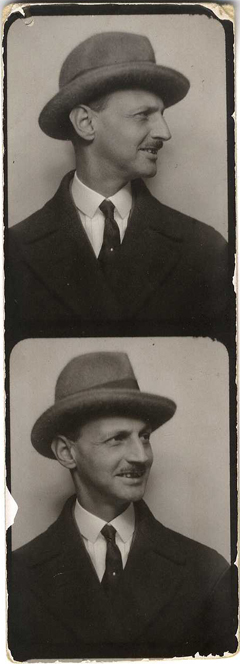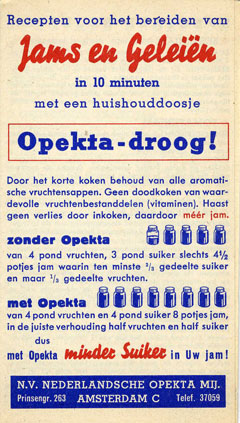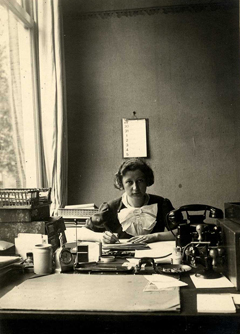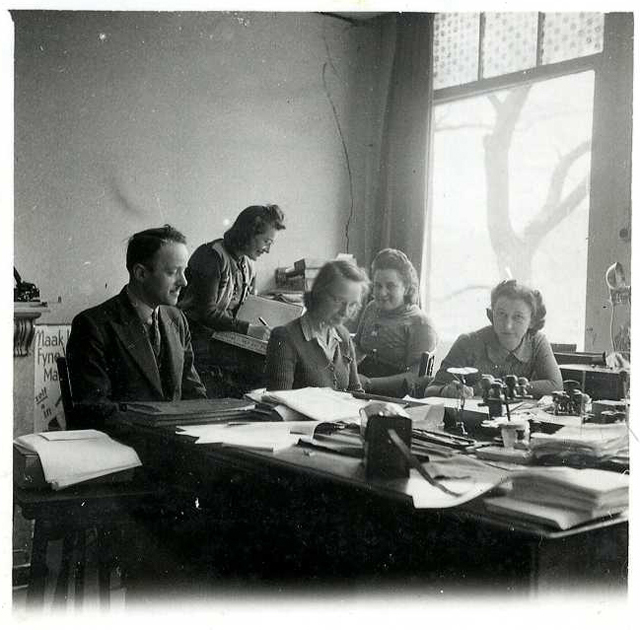
Portrait of Miep Gies in the mid 1930sAfter Miep Santruschitz left school at the age of 18, she first found a job as office assistant at a textile company. She worked there for six years, until she was laid off in 1933 on account of the economic crisis. Now aged 24, she remained unemployed for a few months, since it was difficult to find a new job. But she was lucky: an upstairs neighbor, who worked as a sales representative, told her of a temporary vacancy at one of her permanent clients, the Nederlandsche Opekta company, specialized in the trade of Opekta, a substance used in the household production of jam. The neighbor arranged an interview with Mr. Otto Frank, the company's director, established at Nieuwezijds Voorburgwal 120-126 in Amsterdam. On a Monday morning she rode her bicycle to that address, wearing a carefully ironed, self-made dress and blouse with high heel shoes, and her hair done up according to the latest Hollywood fashion with a loose knot in her neck. Her friends said she looked like the American film star Norma Shearer, and she wore high heels to compensate for her slight length of just 1.52 meters.

Two passport photos of Otto Frank, ca. 1933She was received cordially at the office of Otto Frank, and after he apologized for his poor Dutch they quickly switched to speaking German, their native tongue.’ 'He must have responded favorably to me, because he said to me, “Before you can start, you must come with me to the kitchen.” My cheeks felt hot. Did I have the job? I couldn’t imagine what he could want in the kitchen: perhaps a cup of coffee? But naturally, I followed him into the kitchen. He handed me a sheet of paper. “Here’s the recipe. Now make jam!” He turned and left, leaving me standing alone in the kitchen.’
Miep was once again lucky, as she was hired for the job although there were other candidates. She came through the test of competence with flying colors, making jam and continuing to do so for the next two weeks. She became a veritable expert and knew exactly how to achieve the right color, density and fruity flavor. Otto Frank later even made an commercial for Opekta, in which Miep appears as the expert jam maker.
Mr. Frank told her that he lived in a small hotel in the center of town while waiting for the arrival of his family, who were still staying with his mother-in-law in the German town of Aachen. He told her about his wife Edith and their two young daughters, Margot Betti and Anneliese Marie. Margot was the eldest, born in 1926, and Anne was three years younger. Otto Frank was lonely and hoped to be reunited with his family in Amsterdam as soon as possible. He developed a good relationship with Miep. Both could passionately discuss political topics, although they often held the same opinion about various situation and events. Both were vehemently opposed to Adolf Hitler, who had been inaugurated as the German Chancellor following his election victory earlier that year. Otto Frank had left his homeland on account of Hitler's anti-Jewish politics.

Advertising Opekta jam.After the first two weeks of making jam, Mr. Frank brought Miep out of the kitchen and pointed her to a desk next to the window. "You’ll now sit at this desk. I call it the Complaint and Information Desk. You’ll know why shortly.” Miep took the calls from indignant housewives that had bought the Opekta jam kit but had not followed the instructions, and whose jam therefore failed. It was Miep's job to first calm the ladies down, to then ask them to describe the end product, and to deduce from that what mistake they had made and how it could be remedied. The result was generally a customer satisfied after all.
Miep enjoyed her work and counted herself lucky for having found a nice job in a pleasant setting, while many of her peers remained jobless in those challenging years of crisis. Besides Otto Frank, there was also a Mr. Kugler that worked at Opekta. He was a serious man in his 30s who never joked around. Victor Kugler was born in Austria, just like Miep, and he mainly minded his own business. He would send the messenger boy Henk out on errands and would check his work. Henk was a friendly, agreeable boy. Miss Heel was another of Miep's colleagues. Miep had been hired to replace Miss Heel while she was ill, but after she recovered and returned the work, Miep was allowed to stay on, sharing a room with Henk. Miep didn't get along too well with Miss Heel, especially not after she became member of the NSB (a Dutch political association that sided with the Nazis). After some time Miss Heel called in sick and never came back. "Jokingly, Mr. Frank announced: “... an easy way to lose a Nazi.”

At the office, around 1936.In the fall of 1933, Edith Frank traveled up and down between Aachen and Amsterdam, attempting to find a suitable house. In November she succeeded and from then on Otto Frank rented a house close to where Miep lived in the neighborhood of Amsterdam-South, a district that had become home to many German refugees in recent years. Margot joined them in Amsterdam in December, and Anne soon followed in February 1934. Edith's mother, Mrs. Holländer, also moved to Amsterdam.
In 1937 the Nederlandsche Opekta company moved to Singel 400, a tall canal house of a few floors, with a stockroom on the ground floor. Since the Opekta trade for fruit jams was a seasonal trade, Otto Frank sought to expand the business activities. He met Hermann van Pels, who was specialized in herbs and spices for meat. Otto Frank thought that this was a suitable market to expand into, and he invited Hermann van Pels to join his company. Hermann was an old business friend of Otto who had lived many years in Germany, although his parents were Dutch Jews. He too had fled Hitler Germany with his German Jewish wife named Auguste, and their son Peter. Van Pels became the consultant and specialist for the Pectacon spice trade, as the second component of the Nederlandsche Opekta company.
In January 1940, the company again moved to larger premises, this time to Prinsengracht 263, nearby the Westerkerk (Wester Church). The building consisted of a front and rear house with office space and a large stockroom. Henk had left the company and two new stockroom assistants had joined. In the office, Miep had a new colleague, the 21-year old Bep (Elisabeth) Voskuijl. Bep and Miep got along very well, becoming friends besides being colleagues. Otto Frank had also taken on Johannes Kleinman, described by Miep as "a calm personality, someone that you immediately trust". Frank and Kleiman worked for Opekta and took care of the financial aspects. Kugler and Van Pels worked for Pectacon and concentrated on the spices. They specialized in herbs and spices used to make sausages.

In the office at Prinsengracht 263, May 1941. With Victor Kugler, Bep, Miep and 2 personnel members.
All quotes in this chapter are taken from the book Anne Frank Remembered. The Story of the Woman Who Helped to Hide the Frank Family. By Miep Gies with Alison Gold. Simon and Schuster, New York 1987.
A new edition of the book is expected for early 2009.


